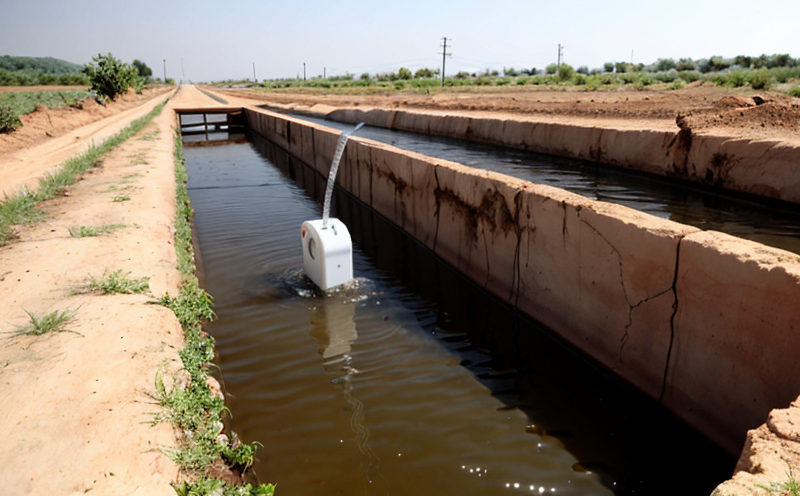ASTM D1125 Electrical Conductivity of Water Testing
The ASTM D1125 Standard Test Method for Electrical Conductivity of Water by Means of Electrode Cells is a critical analytical tool used in the mining sector to ensure water quality standards are met. This test evaluates the electrical conductivity (EC) of water samples, which provides insight into the concentration of dissolved salts and other ions present in the sample.
The ASTM D1125 method is widely recognized as an essential part of environmental monitoring programs aimed at safeguarding both surface and groundwater resources within mining operations. Electrical conductivity serves as a proxy for total dissolved solids (TDS) content, making it useful not only for compliance with regulatory standards but also for process control in water treatment plants.
The test requires careful sample preparation to ensure accurate results. Samples are collected from various points around the mine site, including tailings dams, waste rock piles, and leach pads. Once collected, samples undergo filtration using 0.45 μm filters before being analyzed with an electrode cell connected to a conductivity meter.
The equipment used in this testing process includes:
- Electrode cells
- Conductivity meters
- Filtered water sample containers
- Filtration units (0.45 μm)
Once prepared, the samples are analyzed according to ASTM D1125 guidelines. The conductivity meter measures the resistance between two electrodes immersed in the sample solution. Lower resistances indicate higher conductivity levels due to increased ion concentrations.
The primary outcome of this test is expressed as microsiemens per centimeter (μS/cm), which allows for easy comparison against established benchmarks set forth by regulatory bodies such as the EPA or local state agencies. Compliance with these standards ensures that mined waters do not pose risks to ecosystems downstream from the mine.
For instance, if a mine's effluent discharges into nearby rivers or lakes, exceeding allowable EC limits could lead to harmful effects on aquatic life such as fish populations. Therefore, regular monitoring using ASTM D1125 helps maintain ecological balance and protect public health.
Scope and Methodology
| Key Parameters | Description |
|---|---|
| Sample Collection Points | Tailings dams, waste rock piles, leach pads. |
| Filter Type | 0.45 μm filters used for sample preparation. |
| Instrumentation | Electrode cells connected to conductivity meters. |
The ASTM D1125 method involves collecting water samples from strategic locations within the mine site. These samples are then filtered through 0.45 μm filters to remove particulate matter before being analyzed using electrode cells linked to conductivity meters. The resulting measurements provide a quantitative assessment of the dissolved ion content in the sample.
Industry best practices recommend that these tests be conducted at least quarterly, with more frequent intervals during periods of high rainfall or other conditions likely to impact water quality. By following this schedule and adhering strictly to ASTM D1125 procedures, mining companies can ensure they remain compliant with relevant regulations while also protecting their reputation as responsible stewards of natural resources.
Benefits
- Regulatory Compliance: Ensures adherence to local and international environmental protection laws related to water quality.
- Process Optimization: Helps identify potential issues early by monitoring changes in EC over time, allowing for timely adjustments to treatment processes.
- Risk Management: Reduces the risk of ecological damage or legal consequences through proactive management of mine effluent discharge.
The ability to accurately measure electrical conductivity using ASTM D1125 offers numerous advantages beyond mere compliance. For quality managers and compliance officers, reliable data from these tests provide peace of mind knowing that operations are meeting strict standards set by regulatory authorities. Additionally, R&D engineers can leverage this information when developing new technologies aimed at improving water treatment efficiency or reducing operational costs.
Industry Applications
| Application Area | Description |
|---|---|
| Mine Water Monitoring | Detects changes in water quality due to natural processes or human activities. |
| Groundwater Quality Assessment | Evaluates the impact of mining activities on groundwater resources. |
| Tailings Management | Monitors the stability and safety of tailings storage facilities by tracking changes in water quality over time. |
The ASTM D1125 test has widespread applications across multiple aspects of mining operations. One key application is mine water monitoring, where regular testing helps maintain compliance with discharge limits imposed by regulatory agencies. Groundwater quality assessment plays another crucial role since many mines are located near sensitive ecological zones, necessitating careful management to prevent contamination.
Another important use case involves tailings management, which encompasses the storage and treatment of waste materials generated during mineral extraction processes. By continuously monitoring the water within these facilities using ASTM D1125 methods, miners can ensure that their operations remain safe for all stakeholders involved.





